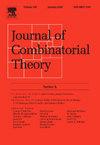q-可除设计图和Deza图的类似物
IF 1.2
2区 数学
Q2 MATHEMATICS
引用次数: 0
摘要
可分割设计图形是由Haemers、Kharaghani和Meulenberg在2011年引入的。本文引入了可分设计图的q-类似的概念,证明了所有可分设计图的q-类似都来自于扩展,并且实际上是强正则图的q-类似。Deza图是由Erickson、Fernando、Haemers、Hardy和Hemmeter于1999年提出的。本文引入了Deza图的q类。进一步,我们确定了可能的参数,给出了Deza图的q-类似的例子,并刻画了所有具有最小参数的Deza图的非强正则q-类似。本文章由计算机程序翻译,如有差异,请以英文原文为准。
q-Analogs of divisible design graphs and Deza graphs
Divisible design graphs were introduced in 2011 by Haemers, Kharaghani and Meulenberg. In this paper, we introduce the notion of q-analogs of divisible design graphs and show that all q-analogs of divisible design graphs come from spreads, and are actually q-analogs of strongly regular graphs.
Deza graphs were introduced by Erickson, Fernando, Haemers, Hardy and Hemmeter in 1999. In this paper, we introduce q-analogs of Deza graphs. Further, we determine possible parameters, give examples of q-analogs of Deza graphs and characterize all non-strongly regular q-analogs of Deza graphs with the smallest parameters.
求助全文
通过发布文献求助,成功后即可免费获取论文全文。
去求助
来源期刊
CiteScore
2.90
自引率
9.10%
发文量
94
审稿时长
12 months
期刊介绍:
The Journal of Combinatorial Theory publishes original mathematical research concerned with theoretical and physical aspects of the study of finite and discrete structures in all branches of science. Series A is concerned primarily with structures, designs, and applications of combinatorics and is a valuable tool for mathematicians and computer scientists.

 求助内容:
求助内容: 应助结果提醒方式:
应助结果提醒方式:


